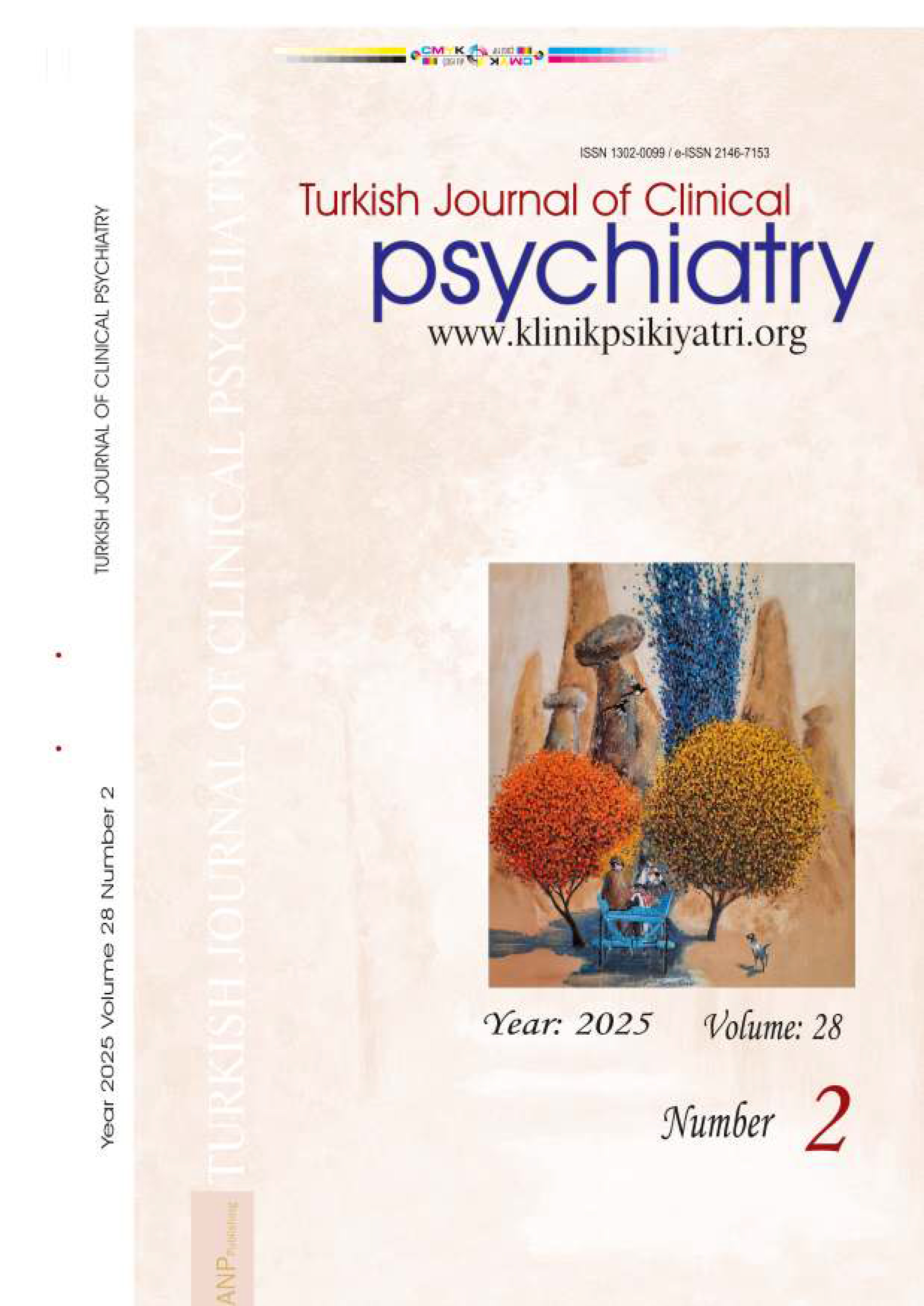





Volume: 6 Issue: 4 - 2003
| RESEARCH ARTICLE | |
| 1. | Depression, Anxiety and Behavior Among Adolescents in Two Affected Areas after the Marmara Earthquake Osman SABUNCUOGLU, Ahmet ÇEVİKASLAN, Meral Berkem Pages 189 - 197 The main purpose of this study is to determine anxiety, depression and behavioral profile in the aftermath of Marmara earthquake in 25 adolescents who had been placed to Gölcük Ford- Otosan Camp and 24 adolescents who are living in istanbul- Avcilar region and to determine the contribution of location, gender and housing conditions. In this study carried out at six months after the earthquake, the subjects aged as 13-18 years filled out the Children's Depression Inventory (CDI) and Spielberger's State-Trait Anxiety Inventory for Children (STAIC). The parents completed the Child Behavior Checklist (CBCL). Results suggest that the two samples do not display statistically different rates of depression, anxiety and behavior. The only subscale on CBCL above the cutpoint of 60 is the Anxious-Depressed subscale of Gölcük sample. State anxiety scores of girls were found to be higher than boys in Gölcük sample (p=0.0345). Girls also have higher rates on the Withdrawn, Somatic, Social poblems and Aggression subscales (p=0.0018, p=0.0312, p=0.049l, p=0.0088) and lower rates on the School subscale of CBCL (p=0.0005) than boys in the Avcılar sample. Impact of the disaster is similar at the two regions, although Gölcük is at the epicenter, Avcılar is farther. Conditions of having been placed to a camp or living at home do not correspond to any significant differences between the groups. More frequent gender differences in Avcılar sample may be due to not living in the same community and sharing emotional intimacy unlike the Gölcük sample. |
| 2. | Assessment of Expressed Emotion and Family Environment in Schizophrenic Patients Verda Tüzer, Ayşe Devrim BAŞTERZİ, Çiğdem AYDEMİR, Cebrail KISA, Erol Göka Pages 198 - 203 Expressed emotion is a measure of the family environment, which is a well-replicated psychosocial predictor of psychiatric relapse. The objective of this study is to investigate the relationship between the family environment and expressed emotion variables with the level of psychopathology. Thirty-two patients diagnosed as schizophrenia according to DSM-IV criteria and one of their family members living in the same house have been included in this study. The patients were assessed by Scale for Assessment of Positive Symptoms (SAPS) and Scale for Assessment of Negative Symptoms (SANS) at the time of admittance, while their relatives were given Family Environment Questionnaire (FEQ) and Expressed Emotion Scale (EES). Furthermore, the patients were evaluated by FEQ and Level of Expressed Emotion (LEE) scales before their discharge from the hospital. The "control" subscale of the FEQ has been found to show positive correlation with the SAPS score of the patients (p=0.008). Positive correlations have been found between the SAPS scores and both total EES scores (p=0.039) and criticism/hostility subscales of EES (p=0.046). Positive correlations have been found between SANS scores and EES total scores of the patients, as well (p p=0.04). There are negative correlations between interpersonal relationship subscale of the FEQ scale and emotional response (p=0.044), negative attitude to illness (p=0.009) and tolerance(expectations subscales (p=0.01). Family environment variables need to be taken into consideration in schizophrenic patients, with regards to the level of psychopathology. Interventions towards improving the family environment may have positive contribution to the course of the disorder. |
| 3. | The Determination of Panic Disorder Subtypes According to Symptoms Sibel Örsel, Olga GÜRİZ, Asena AKDEMİR, Hakan Türkçapar Pages 204 - 212 It has been aimed to investigate panic attack symptomatology in a group of panic disorder patients and to determine the subtypes of panic disorder according to symptoms of panic attack. The 60 patients who applied to SSK Ankara Education Hospital and had been diagnosed as DSM-IV panic disorder were recruited in to the study. Panic attack questionnaire, Hamilton Anxiety Scale and Clinical Global impression scale has been applied. The data were analyzed by student t-test, chi-square and factor analysis principal component method. Heart pounding, feelings of discomfort, trembling, dry mouth, feelings of helplessness and hopelessness symptoms were the most frequent symptoms. While three of them were DSM-IV symptoms, the others especially feelings of discomfort and helplessness were non DSM-IV symptoms. According to symptom dispersion, sweating and nausea were significantly more frequent in women; also the severity of heart pounding, trembling and parestesias symptoms were higher in women with respect to severity of symptoms. Factor analysis revealed four subtypes such as cardio-vasculer, cognitive, gastrointestinal and tense-related symptoms. One of the most important findings of our study is some of the most frequent symptoms such as the feelings of discomfort, helplessness, hopelessness were non DSM-IV symptoms. Principal component factor analysis that was used on the severity ratings of symptoms revealed a four factor subtypes. As a result, when we evaluate panic disorder patients we have to pay attention that DSM-IV panic disorder symptoms were not sufficient for determining the subtypes. The studies of outcome and treatment of panic disorder would be productive by determining the subtypes of panic disorder. |
| 4. | Investigation of Hair Lead Level in Autistic Children Özgür YORBIK, Bengü DİLAVER, Adnan CAN SEVER, Cemal AK Ay, Ahmet SAYAL, Teoman SÖHMEN Pages 213 - 216 Lead is a toxic element for central neural system. It was reported that subjects with autism had increased level of lead than controls. The aim of this study is to investigate hair lead levels of autistic children without pica and healthy children. Hair lead levels were measured with graphide furnace spectrophotometry in hair samples that were obtained from occipital regions of 35 children with autism and 29 healty children. Any significant difference for hair lead levels was not found between the autistic children and healthy children (p>.05). This study supported that autistic disorder was not related to increased hair lead level. |
| 5. | The Use of Suicide Probability Scale in High School and University Students in Turkey Ayşe Gülsen CEYHUN, Birsen CEYHUN Pages 217 - 224 There is a growing concern for identifying individuals at risk for suicidal behaviors. This study aimed to explore the suicide prob-ability in high school and university students in Turkey. Subjects were 600 high school and 800 university students. The Suicide Probability Scale (SPSj was given to the students in their classes. The mean of the SPS in high school students is 65.33 and university students is 59.51. The sample scored significantly higher than the Cull and Gill's normative and the Turkish standardization sample. Also the subscale scores of the groups are higher than the Cull and Gilts normal and inpatient group. Findings suggest the need for additional research regarding the instruments efficacy in distinguishing between normal and suicidal adolescents. |
| REVIEW | |
| 6. | Kidney Transplantation and Psychiatry Gamze OZÇURUMEZ, Nilgün TANRIVERDI, Leyla ZİLELİ Pages 225 - 234 Preoperative psychiatric evaluation of a recipient in kidney transplantation includes doing his/her mental state examination, taking the psychiatric history; if there is a psychiatric disorder considering its relapse risk, paying attention to the probable pharmacokinetic and pharmacodynamic changes due to renal failure and to the interactions between the immunosupressant and psychotropic drugs. History of treatment compliance, degree offamily and social support received by the patient, preparedness to transplantation process in terms of cognition and emotion, ability of judgment, degree of expectations from the transplantation procedure and whether they are realistic, coping skills, frustration tolerance and impulse control of the recipient are the other factors those have to be evaluated. For most of the centers the primary reason of psychiatric evaluation during the transplantation process is to identijy the possible noncompliant patients in advance and exclude them from the program. There are no standard psychiatric evaluation criteria for the donors. The psychiatric evaluation of a donor include inquiry into the donor’s mental stability, degree of ambivalence, ability to assume responsibility for his or her decision, whether he/she has information about the possible complications of the donation and probability of rejection of the donated kidney, past psychiatric history, the motivation to donate, family dynamics and signs of hazard to donor-recipient relationship post-operatively. In this paper, selection of recipient and donor candidates, psychi-atric problems during the transplantation process and the effect of these problems onto the quality of life are aimed to be reviewed. |
| CASE REPORT | |
| 7. | Different Prognosis of Pervasive Developmental Disorders Ayşegül YOLGA TAHİROĞLU, Sunay FIRAT, Rasim SOMER DİLER, Ayşe AVCI Pages 235 - 239 Pervasive developmental disorders appear every early in childhood and cause life-long significant symptoms. When autistic symptoms are present in the early childhood, the first diagnoses to be considered is one of the disorders classified usually in the autistic spectrum disorders. However, the diagnosis of some cases may change during follow-up or a comorbid condition may supercede the clinical picture. In this report, we present a boy who was diagnosed with autistic disorder at 21 mounts of age and showed attention deficit hyperactivity disorder symptoms and has shown no autistic symptoms at school age; and a girl who was followed up with mild autistic symptoms and developed significant obsession and tics at school age. |
| 8. | Monosymptomatic Hypochondriasis; A Case Report şükrü UGUZ, Hüner AYDIN, Ebru Yurdagül Pages 240 - 243 Delusional disorder is the current classification for a group of disorders of unknown cause, which is primary feature is the delusions. Delusional disorders are uncommon, but probably not as rare as previously thought. Somatic type delusional disorder with hypochondriac delusions has been called monosymptomatic hypochondriacal psychosis. The condition differs from others with hypocondriacal symptoms in degree of reality impairment. We reported here a case who had a surgery for disc hernia and had sixteen of his teeth pulled out as a result of his somatic of having a nervous spasm. This case is presented because of extraordinary context and its consequences. |










